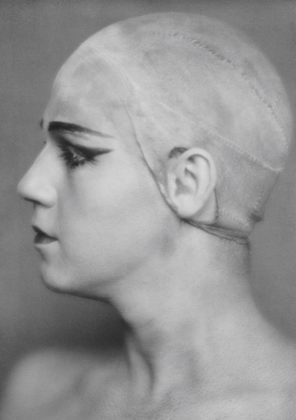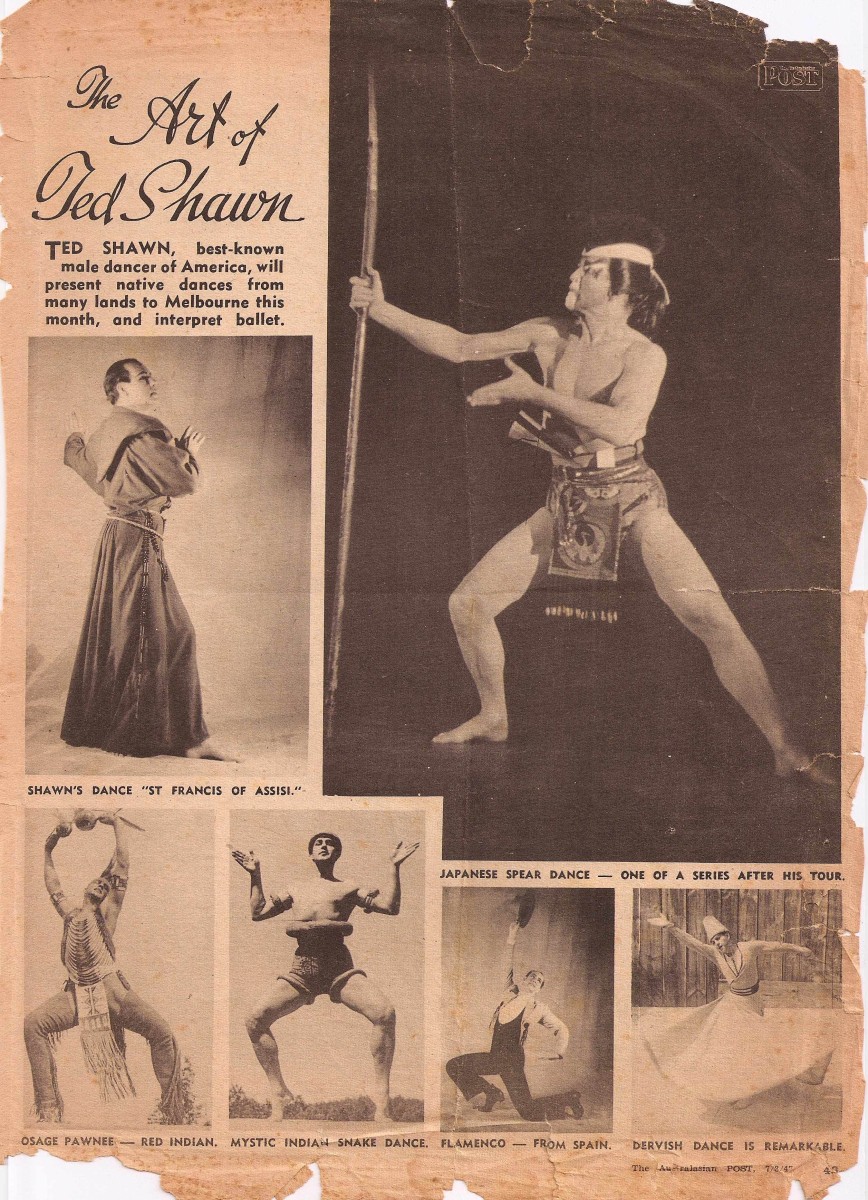Back in May of this year I was lucky enough to see the exhibition of works by photographer E. O. Hoppé at the National Portrait Gallery in London. My post relating to that show concerned portraits of Margot Fonteyn and Olga Spessivtseva. The National Portrait Gallery’s show, Hoppé portraits: society, studio & street, closed shortly after I’d written that post but images of American dancer Ted Shawn, which were part of the Portrait Gallery show, have continued to resonate in my mind ever since.
One, taken in 1922, is a head and shoulders portrait of Shawn in Tillers of the Soil, a stylised dance he created in which he and his wife, the dancer Ruth St Denis, represented an ancient Egyptian couple tilling the soil. The portrait of Shawn is a bold one. And Shawn was a strong, athletic man whose contribution to world dance included the founding of a dance centre in the Berkshire Hills in Massachusetts where he trained a group of male dancers, young college athletes who worked on the farm during the morning and trained in the barn during the afternoons. This centre is still used for dance and is the home of the famous Jacob’s Pillow Dance Festival.

Shawn also brought his distinctive brand of dance to Australia in 1947 at the invitation of an enterprising woman in Perth, Ida Beeby, director of the Patch Theatre Guild and Dance School. Shawn gave a series of lectures and several solo programs of dance in Perth. His repertoire was eclectic and uncompromisingly his own. It included dances of American Indian origin, a Japanese sword dance, some Flamenco dances, and an American cowboy number ‘Turkey in the Straw.’ From Perth he took a side trip to Arnhem Land and entertained indigenous dancers at Delissaville, who in fact had come to entertain him, with his rendition of a whirling dervish dance. After Perth he moved on to perform his solo shows in Adelaide, Melbourne, Sydney and Brisbane.
Like most artists who visited Australia in the first decades of the twentieth century, Shawn was not averse to making predictions about the future of Australian dance. He wrote regarding Perth:
‘Perth, due to its unique isolation, is ideally the place where a new dance form, growing out of this continent, using the forms of other countries and of the past as a sort of cultural “humus,” can be born, nourished until its integrity is fully established, and then ray out to the rest of Australia and the world’.
Shawn’s visit to Australia has scarcely been examined in this country. A small collection of programs from his Perth seasons is part of the ephemera collection of the National Library of Australia. But Edward Pask in Ballet in Australia. The second act, 1940–1980, the only survey we currently have of Australian dance covering the period of Shawn’s Australian interlude, makes no mention of the visit. I believe, however, there may be archival film footage of his Australian visit in the Jacob’s Pillow Archive at Becket, Massachusetts.
Michelle Potter, 17 August 2011
Image of Ted Shawn in Tillers of the Soil: © 2011 Curatorial Assistance, Inc. / E.O. Hoppé Estate Collection. Courtesy National Portrait Gallery, London.
Image below from The Australasian Post, 7 August 1947, p. 43, kindly supplied by Anne—see comments below.

Michelle, I have an article from The Australasian Post, 1947 :
“Ted Shawn, best known male dancer of America, will present native dances from many lands to Melbourne this month, and interpret ballet.”
There are a series of photos of Shawn in St Francis of Assisi; Japanese Spear Dance; Flamenco from Spain; Dervish dance; Mystic Indian Snake Dance and Osage Pawnee-Red Indian. Would you like me to scan and send?
Also refer to Dance Magazine, July 1990, p 38: “The Treasures of Eustis, Florida: The Denishawn Collection” by Katy Matheson
Thanks Anne. I have added the image from Australasian Post to the bottom of the article above.
The Melbourne appearances are interesting as they were sponsored by Ballet Guild. The first Shawn only recitals at the Union Theatre were so successful that a series of lunchtime recitals, under the auspices of the Ballet Guild, were given at the Melbourne Town Hall. Alongside Shawn’s familiar recital items were the Sugar Plum Fairy solo performed by Strelsa Heckelman, a Delibes Czardas [Coppelia ?] performed by Laurel Martyn, Corrie Lodders and Max Collis together with other Ballet Guild repertoire. Over 2 performances some 5000 people saw these recitals. Shawn appeared to have been taken up by the Melbourne press and there are numerous pars about him and his association with Ballet Guild.
The information about Ballet Guild sponsorship is very interesting. I guess it is just another example of Laurel Martyn’s determination to promote the best dance of the time to Australian audiences. Whatever we might think in 2011 of Shawn’s ethnic-style dances, he was a major influence.
The name Ted Shawn came to me by way of my interest in Valerie Myers who was leading dancer with Danny Pirnitzer and Hanny Kolm and their Modern ballet studio in Melbourne. I understand Shawn was impressed with Myers (17 – 19 at the time) and invited her to dance in the USA. She turned down this opportunity and instead went to Paris, eventually becoming an artist known better as Vali Myers. I have a few press clippings of her dancing (from Australiasian Post in 1949) at Assembly Hall but would love to know more if anyone has more information.
I recall Ted Shawn dancing at the Union Theatre when I worked there as a Union Theatre Technician.
Des Connor sat in his usual place in the auditorium beside the middle row where he could have access to communication to the Electrician on the board (me)
The Manager or Lighting Director or someone sat next to Des Connor and kept on wanting to get more and more light on to the stage. Des believed that the man had no appreciation of theatre lighting and became frustrated.
I remember saying to Des when no further lighting existed to increase the amount of white light – “Everything is on. However would you like me to turn on the scrim light?”
This involved a 60 watt light in blue right at the very top of the theatre above the stage !!
I am beginning research into Ted Shawn’s trip to Australia. The Pillow do indeed hold film materials from the trip as well as his diary – he was a prolific writer. If any of those of you who have commented above would like to get in touch please do let me know.
all best
Liz Lea
Hi Liz
I would very much like to find out a little more about Ted Shawn’s trip to Australia
cheers Tracy
re Ted Shawn 1947/48. I was a young dancer in Patch theatre Perth Aust (Ida Beeby) and remember his visit and his dance energy well. Have a copy of Dance Child-Dance a book by Beeby with a foreward by Shawn.
It is amazing how people keep reading this post. Shawn, I think, deserves more attention in our dance history than he has previously been given. Footage of his perfomances in Australia is held in archives at Jacob’s Pillow. One day I hope to get to see it. I don’t know the book you mention so I will hunt it out. Thank you for your comment.
Hello Michelle,
Ted Shawn visited several indigenous communities to observe Aboriginal dancing on his Australian trip. You can find an account in Walkabout’s Australia (1964), an anthology of articles from Walkabout magazine, in John K. Ewers “Aboriginal Ballet.” Shawn was enthusiastic about what he saw.
Hi Ingrid, Thank you for this information. I have just noticed that the papers of John K. Ewers are held by the Battye Library in Perth and it seems to be a substantial collection. It may be worth investigating.
Thanks again.
Michelle